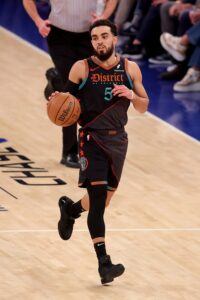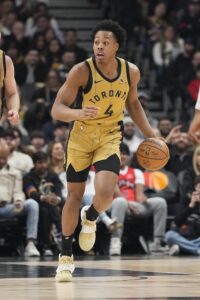NBA teams are each permitted to carry up to three players on two-way contracts, which means at any given time there could be a maximum of 90 players on two-way deals around the league.
[RELATED: Hoops Rumors Glossary: Two-Way Contract]
Of course, while it’s common for the NBA-wide total to hover at or near 90 for much of the regular season, we’re only 23 days into the 2024/25 league year, so many teams have yet to fill all of their two-way slots.
Still, some clubs haven’t wasted much time in signing players to two-way contracts. At the moment, as our tracker shows, 62 of the 90 slots around the league are occupied and two more are spoken for — Spencer Jones has reportedly agreed to a deal with Denver and Jack McVeigh is reportedly signing with Houston.
We’re still about three months away from the 2024/25 regular season tipping off, and since two-way deals don’t affect a team’s cap situation, it won’t be a surprise if many teams rotate players in and out of those roster spots up until the season begins (and after that). But for the time being, there are just 26 open two-way slots across the league. Here’s the breakdown:
Teams with multiple open two-way slots
- Brooklyn Nets (2)
- Cleveland Cavaliers (3)
- Indiana Pacers (3)
- Los Angeles Clippers (2)
- New York Knicks (2)
- Orlando Magic (2)
- San Antonio Spurs (2)
Some of these spots may already be spoken for. For instance, the Cavaliers (Emoni Bates), Pacers (Oscar Tshiebwe and Quenton Jackson) and Knicks (Jacob Toppin) still have two-way qualifying offers on the table to restricted free agents. If those players eventually accept those offers, they’ll be back with their respective clubs on new two-way contracts.
Some of these clubs – including the Pacers with Tristen Newton and Enrique Freeman, the Knicks with Kevin McCullar, and the Spurs with Harrison Ingram – also have second-round picks from this year’s draft who look like logical candidates for two-way spots.
Still, with multiple openings, many of these teams are in position to identify Summer League standouts whom they want to bring to training camp. They could offer them two-way deals or could try to sign several players to Exhibit 10 contracts and create an open competition for two-way spots this fall.
Teams with one open two-way slot
- Atlanta Hawks
- Boston Celtics
- Charlotte Hornets
- Dallas Mavericks
- Detroit Pistons
- New Orleans Pelicans
- Phoenix Suns
- Portland Trail Blazers
- Utah Jazz
- Washington Wizards
As with some of the teams above, there are a few cases here where there’s one obvious candidate to fill these two-way openings. It would make sense, for example, for the Celtics to sign No. 54 overall pick Anton Watson to a two-way deal.
That’s not the case for all of these openings though, so agents whose clients are seeking an 18-man roster spot will likely reach out to these clubs to see how they intend to use their third two-way contract slot.
Teams with no two-way openings
- Chicago Bulls
- Denver Nuggets
- Golden State Warriors
- Houston Rockets
- Los Angeles Lakers
- Memphis Grizzlies
- Miami Heat
- Milwaukee Bucks
- Minnesota Timberwolves
- Oklahoma City Thunder
- Philadelphia 76ers
- Sacramento Kings
- Toronto Raptors
In theory, these 13 teams are good to go for training camp. In actuality, I could see half of them making two-way changes by the start of October. The Heat, for instance, had some non-roster players on their Summer League team outperform their two-way players and have some decisions to make on which three players they want to bring to camp on two-way deals.
 As the Wizards’ starting point guard, Jones established new career highs in field goal percentage (48.9%), three-point percentage (41.4%), points per game (12.0), and assists per game (7.3) while continuing to protect the ball better than just about anyone in the league. His 1.0 turnover per game in ’23/24 represented the worst mark of his career.
As the Wizards’ starting point guard, Jones established new career highs in field goal percentage (48.9%), three-point percentage (41.4%), points per game (12.0), and assists per game (7.3) while continuing to protect the ball better than just about anyone in the league. His 1.0 turnover per game in ’23/24 represented the worst mark of his career. A rookie scale contract for first-rounders is always for two guaranteed seasons, with team options for the third and fourth seasons of the deal. The scale amount is strictly set by draft position for the first three years of the contract, with the amount of the fourth year determined by a percentage raise on the third-year salary, as RealGM’s
A rookie scale contract for first-rounders is always for two guaranteed seasons, with team options for the third and fourth seasons of the deal. The scale amount is strictly set by draft position for the first three years of the contract, with the amount of the fourth year determined by a percentage raise on the third-year salary, as RealGM’s 

 Extensions, of course, don’t involve adding a new player to the roster. By extending a contract, a team ensures that a current player will remain locked up for multiple years to come. Although a contract extension may not change the club’s short-term outlook on the court, it can have a major impact on that team’s salary cap situation for the next several seasons.
Extensions, of course, don’t involve adding a new player to the roster. By extending a contract, a team ensures that a current player will remain locked up for multiple years to come. Although a contract extension may not change the club’s short-term outlook on the court, it can have a major impact on that team’s salary cap situation for the next several seasons.